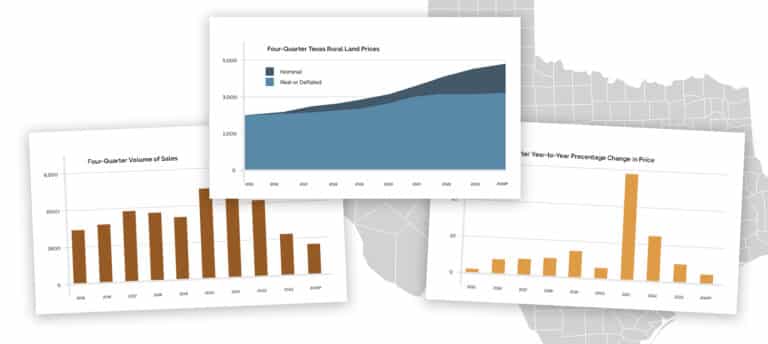Last January, I hosted a group of clients for a duck hunt on the Texas coast. Huge groups of redheads flock together during the late season, and when they commit to the decoys, the hunter who takes careful aim can fill his bag with drakes in a hurry! One of my companions, however, was not having a productive hunt. Opportunities were abundant, and he was shooting aggressively, but his shots rarely connected. When he did hit a duck, he was just as surprised as we were!
But, more often we heard the words, “%$#@, I should have aimed better!”
He failed to follow the proven “ready, aim, fire” model.
Unfortunately, this sounds too much like how many real estate agents approach the land business. Abundant opportunities, lucrative commissions and time spent outdoors tend to attract these folks to the land business. But many operate their businesses in a reactive fashion, simply taking what the market gives them. While they may feel busy, their business is unpredictable and it leads to the high percentage of agents who fail to make it past five years in this business.

Strategic planning for your land sales business boils down to a few simple steps: set clear, written goals (ready), identify the specific activities to get you there (aim), then execute the plan (fire). Top agents who do take time to strategically plan have a more predictable business and, consequently, they operate with more clarity. Core business and operational decisions become much easier with a predictable business. Hiring, debt, expansion, marketing and scheduling are much easier if you can confidently predict the results you will likely achieve.
As you plan your business empire, you should start by considering where your leads will come from. Use a simple spreadsheet or one of the many software programs available online to track your lead sources by percentage and volume. By identifying your core sources of business, you can confidently plan your activities, make better marketing decisions and bring in the proper leverage to maximize the potential of these lead sources. Additionally, this will force you to calculate the cost of these leads, which will come in handy when doing your pro forma. Knowing the sources of your business is the first step to clear planning.
Now, let’s look at three basic components of a productive and clear business plan. Remember, this is a plan for you to follow, not a 50-page textbook that requires a Ph.D. to interpret! The idea of a business plan is to clearly lay out the specific steps and activities required to reach your goals, and to project profitability once you reach them. The three basic components we will look at are: the Financial Model (or Pro Forma), the Organizational Model (who does what) and a One-Page Plan with written goals and the clear steps to accomplish them.
Top businesspeople know their numbers and track them closely. The Financial Model, or pro forma, is where you write down how much income you would like to net and calculate all the costs associated with getting to that number. According to the Millionaire Real Estate Agent model, start with your desired net income, then back into the total sales required to support this goal. For example, if I want to net $300,000 in annual income (before taxes), I would write down $300,000 + $87,600 (29.2% cost of sales) + $87,600 (29.2% operating expenses) to get my total required gross commission income (GCI) = $475,200. Now I know how much revenue I will need to bring in to support my income goal and I can calculate how I will get there. To do this, divide $475,200 (GCI) by 3% (your average commission rate) to get the necessary total sales volume. In this example, I would need to close $15,840,000 in sales volume to reach my goal. Next, I will need to know my average sales price to calculate the number of transactions needed to reach my goal. My average sale has been tracking around $2,000,000. $15,840,000 divided by $2,000,000 tells me I need to close 7.9, or 8, transactions at 3% to reach my goal. Now, I simply plug in the percentage of listings I expect to close (65%) from the appointments I expect to win (70%) to get the number of listing appointments I will need to set. In this example, I would need to go on 18 listing appointments in order to predictably win 12 so that I could expect to close 8 property transactions. If they average $2,000,000 and I earn 3% commission, my GCI will be $480,000. After expenses and cost of sales, I will reach my income goal of $300,000. *see chart on page 4 of the Millionaire Real Estate Agent Business Plan
The success of any sales business boils down to the right amount of quality leads.
The success of any sales business boils down to the right amount of quality leads. The Financial Model showed me how many leads I need to generate to reach my financial goal; now I can build a plan to get there. We have found a simple, single-page business plan to be the most effective way to do this. The COB and CEO of the largest real estate company in the world can fit theirs on a single page, so we can too! The single-page business plan requires extreme clarity on the goal and the specific things that must happen in order to accomplish the goal. In his book The ONE Thing, Gary Keller asks the question, “What’s the ONE Thing I can do such that by doing it everything else will be easier or unnecessary?” This clarity allows you to line up your dominoes and start with the most important task first. Focus on the big rocks, the things that only you can do, and break them down into action items.
We start with a written five-year goal, a written one-year goal, three top priorities that absolutely must happen to ensure the one-year goal is met and five strategies to accomplish each priority. We creatively refer to this exercise as the 1-3-5 goals sheet. Going back to my example from the Financial Model, I would write my one year goal of $300,000 net income and roughly $16,000,000 in sales volume. My five-year goal is a stretch goal, but for the purposes of this exercise it won’t matter unless I hit my one-year goal. Next, I need clarity on what the three things are that must happen to support my goal. These are my top three priorities, and I write them down as well. First, I know I will need $24,600,000 in listing inventory (12 listing agreements at a $2,000,000 average) to predictably close $16,000,000 (65%). Then I break down my five strategies to get there. Secondly, I know I will have to nail lead generation, and third, I will need a solid marketing plan. Each of these gets the same five detailed strategies. If I have clarity on these big rocks, I can dig into each of them and hold the activity (and the person attached to it) accountable for producing the results.
Now that I have completed my Financial Model and I have clarity on the core things that must happen to support it, my final step is the Organizational Model. This is where I bring in leverage and assign who does what in the business. I cannot do everything, and in fact I shouldn’t. There are things I do poorly, like administrative work and bookkeeping. There are others who do those very well, and by delegating to them, I am released to do the things I do well—like lead generation and interacting with clients. Leverage is freedom for business owners. It allows you to scale by staying in your strength zone and working on the business, rather than in the business. Leverage could be defined as strategically removing yourself from every aspect of your business based on your skill set and the value of your time. For most real estate agents and business owners, the logical first hire is an executive assistant, followed by a buyer agent and maybe a second assistant. Draw a simple org chart with clarity on who does what and who they report to. As your business grows, you add future hires under them and build a job description or “missing person’s report” for these future hires. Hiring for the future with a big goal in mind changes the way you hire and lead people. Success through people is one of the hardest things for most entrepreneurs to master, but for most, it is the single largest factor in their ceiling of achievement.
If you own or operate multiple businesses like I do, then simply do these steps for each business and combine the results. With multiple businesses, you would also consider shared resources, shared employees and weigh any direct ancillary benefits of one business to another. For example, a farm management company and a land sales company might complement each other quite well by maximizing the client opportunity and sharing administrative expenses.
Lastly, you will likely not nail this on the first or even the hundredth try! So inspect what you expect, monitor your progress regularly with good accountability and make adjustments as you go. What you focus on expands. Have a predictable written plan and focus on the detailed activities that will produce the results you desire.


